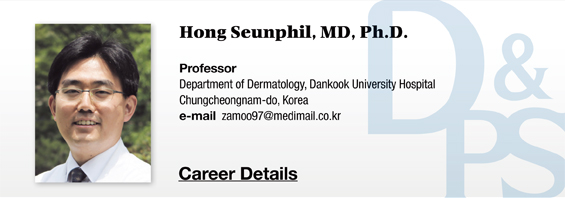‘Best Lecture’ introduces famous lectures in dermatology and plastic surgery held in Korea. This will provide you with the opportunity to see distinguished lectures regardless of time and place. The lecturer of this lecture is Dr. Hong Seung-pil, professor of dermatology in Dankook University Hospital. This is the summary of Dr. Hong’s lecture given at a symposium held by Korean Society for Laser Medicine and Surgery in May this year. <Editor’s note>

As you all know very well, Nd:YAG laser is a 1064nm mid-infrared laser. There are currently a variety of Nd:YAG lasers released in the market. Although Nd:YAG laser is 1064nm, frequency doubling induces 532nm, thereby generating both 1064nm and 532nm.
Lasers typically damage what’s on the surface of the skin, but also what’s inside the skin, for pigmented or vascular lesion. If you look at the interaction between the skin structure and laser, the melanin layer in the epidermis first obstructs the laser, as it obstructs UV rays. The dermis scatters and absorbs laser light. Blue wavelengths are well scattered in the dermis, generating Tyndal effect, which is also the principle behind the sky looking blue.
[Advertisement] MAGNUM(Q-switched Nd:YAG Laser) – Manufacturer: (www.i-dana.com)]
Greater energy is generally associated with longer penetration depth. Epidermal lesions do not require high energy, compared to deeper lesions requiring greater energy, which is also true for wavelength. Short wavelengths, such as 532nm, cannot penetrate deep but is useful for treating epidermal lesions. Longer wavelength means increased skin permeability. Above 1200nm, the absorption by water is increased but the penetration depth becomes decreased. Larger spot size means deeper penetration. An appropriate laser wavelength is selected for individual lesion, based on these conditions.

TRT and Pulse Duration
The theory of ‘Selective Photothermolysis’ is applied when damaged intended target only. The irradiated pulse width should be lower than the ‘Thermal Relaxation Time (TRT)’ of melanin to damage the intended target only, without causing damage to the surrounding tissues. Excessive energy might exert damage, but too much energy might prevent achieved wanted effect, due to scarring or PIH.
Each wavelength has different absorption coefficient. Higher wavelength generally is associated with less absorption by melanin. 532nm has high absorption by melanin. Ruby or Alexandrite laser is also used for damaging melanin. The TRT of melanosome is less than 500 nanoseconds, and requires shorter duration of laser to be damaged. The pulse duration of Nd:YAG laser is about 10 nanoseconds. Since tattoo ink is placed by human, some are bit, some are small and others become smaller by damage. The sizes are more various than melanosome, but many of them are so minute that lower level of pulse duration would be appropriate.
Q-switched mode is a technology of cutting wavelengths short for generating short nanosecond. This mode can damage target melanosome by stronger and shorter, punctuated wavelength. Melanins may burn by heat from Q-switched mode, or burst and divided to smaller pieces by photoacoustic effect. Pigmented diseases of the skin can be categorized to epidermal and dermal disease. It is general that epidermal diseases are treated than dermal diseases.


Clinical Cases
Solar lentigo
Lentigines are easy to treat and shows clear boundary at the areas exposed to sunlight. It occurs commonly on the back of hands of the elderly. Lentigines caused by sunlight is called solar lentigines. CO2 abrasion alone is highly therapeutic but Nd:YAG laser is used to avoid damages. Freckles appear similar and also occurs on areas exposed to sunlight, but the size is smaller and are more common in younger ages.
I conducted a clinical study on solar lentigines. Nd:YAG laser at 0.7-0.8J, 3-4mm spot was performed in 20 patients with solar lentigines. Ninety percent of the patients had 60% of their lesions disappeared, and 90% of the patients responded that they were satisfied with the treatment. There was a slight pain for side effect, but not intolerable. Some patients had erythema and hyperpigmentation on the treatment site, which were not very severe.



-To be continued-
▶ Previous Artlcle : #5-2. Various Pigmented Lesions with Q-switched Nd:YAG Laser





















